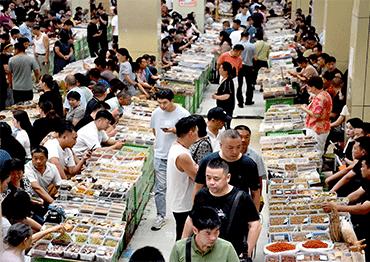Analysts believe the most recent price hikes were caused by speculators who, amid a slowing global economy, are investing in TCM as an alternative to financial products. Underneath this, long term structural and systemic issues across the TCM medicinal herb industry are the root causes of price volatility, which cannot be solved without government intervention, they said.
Herbal ingredients for TCM like roots, seeds and other plant parts can either be used to manufacture drugs, or they can be processed into compound formulas to make herbal teas and infusions. All of those medications are available at hospitals, clinics and drug stores.
Lin Hao, who owns a TCM store in Anguo, Hebei Province, the biggest TCM herb market in North China, told NewsChina that Chinese caterpillar fungus, an already expensive ingredient collected on the Qinghai-Xizang (Tibet) Plateau used to reinforce the kidneys and lungs, has shot up in price this summer.
“It’s gone through the roof. It’s shot up by more than 40,000 yuan (US$5,714) per kilo to 90,000 yuan (US$12,857) per kilo,” he said, adding that high-quality fungus can go for up to 160,000 yuan a kilo (US$22,857).
Chen Yun, who has been selling TCM ingredients in Anguo for 30 years, told NewsChina that the price of wild jujube seeds, used to treat heart palpitations, has jumped to a record high of 950 yuan (US$130) per kilo, three times more than in early 2022.
Data from zyctd.com, another TCM information website, shows that a number of TCM plants and even other ingredients, like animal bones, have seen their price multiply between early 2020 and the end of 2022. Flatstem milkvetch (semen astragali complanati), used to reduce blood pressure and lipids, soared from 24 yuan (US$3) per kilogram to 150 yuan (US$21).
“June is hot and rainy, which means higher storage and transportation costs, so it’s usually a slack month. But this June, we saw an unprecedented increase in prices for many more plants and herbs,” Jia said, adding they observed the highest increases in plant ingredients for basic medications that are covered by government medical insurance. “It indicates that the market is nearly out of control, and this could heavily impact the country’s strategic safety net [for TCM drugs] and the stability of the social medical insurance system,” he warned.
“The influence of the price rise has already spread to end users. Many patients complain that TCM meds are increasingly unaffordable, so I sometimes have to reduce the dose or swap it out for a cheaper one,” An Wanjun, a doctor at a TCM clinic in Hangzhou, Zhejiang Province, told NewsChina.
“Often, we see prices of a few herbs go up, but rarely like this summer, when so many have gone up,” An said.
Sales of some ingredients, like wild jujube, have stalled due to the high prices. Chen Yun said that patients are asking for cheaper substitutes. For example, codonopsis pilosula, a plant in the bellflower family, is used to replenish energy, but it can be replaced by the much cheaper false starwort (radix pseudostellariae).
Zhang Li has seen her direct sales to pharmaceutical companies decline. “We used to sell a great deal of licorice every year, even over 100 tons in golden periods... But after the price rise, my store only sold a total of 20-30 tons of [all types of] herbs from January to June,” she said.
Cold storage facilities in Anguo normally used for fresh produce are full of medicinal plants bought at top prices, many dealers told NewsChina.
Zhang Cheng, who grows TCM herbs in Anguo, told NewsChina that cold storage facilities had previously struggled to turn a profit, but now space is at a premium. A nearby facility raised its monthly fee from 105 yuan (US$15) per ton to 150 yuan (US$21). “But some plant ingredients go bad in long-term storage and they can only be sold for use in animals, where the price is only one-tenth of human medications,” he said.

 Old Version
Old Version


